I. SUS304 Stainless Steel – 0Cr18Ni9 Stainless Steel Material
As a fundamental austenitic steel type, it possesses excellent corrosion resistance, heat resistance, low-temperature strength, and mechanical properties. After heat treatment, it does not harden and almost lacks magnetism.
Features and Practical Applications:
| Difference | SUS304 | SUS304L |
| Characteristics | – Austenitic steel is the most widely used base metal type; – Exhibits excellent corrosion and heat resistance; – Provides superior low-temperature strength and mechanical performance; – Consists of a single-phase austenitic structure, with no hardening effect from heat treatment. | -Compared to 304, it has excellent corrosion resistance. |
| Usage | – Cutlery, exterior materials, construction materials, automobile parts; – Medical devices, chemistry, food processing, fiber industry; – Ship components | -Equipment for chemical, coal, and petroleum industries with high anti-crystalline corrosion requirements; -Building materials, heat-resistant parts, and components that are difficult to heat treat. |
Chemical Composition: (Unit: wt%)
| Specification | C | Si | Mn | P | S | Cr | Ni |
| TYPE 304 | ≤0.08 | ≤1.00 | ≤2.00 | ≤0.045 | ≤0.030 | ≤18.0-20.0 | ≤8.0-10.5 |
| TYPE 304L | ≤0.030 | ≤1.00 | ≤2.00 | ≤0.045 | ≤0.030 | ≤18.0-20.0 | ≤8.0-10.5 |
Mechanical Performance:
| Specification | YS(Mpa) | TS(Mpa) | EL(%) | Hv |
| TYPE 304 | ≥205 | ≥520 | ≥40 | ≤200 |
| TYPE 304L | ≥175 | ≥480 | ≥40 | ≤200 |
II. SUS 430 Stainless Steel
1. Overview
Composed of 17% Cr, it exists in a mixed phase (α+γ) at high temperatures, and is a single-phase BCC structure below 1000°C. This ferritic stainless steel is widely used.
2. Characteristics
1) Excellent deep drawing performance, similar to 304 steel.
2) Strong resistance to oxidative acids, also has a certain corrosion resistance to alkali solutions, most organic and inorganic acids. It has higher stress corrosion cracking resistance than 304 steel.
3) The thermal expansion coefficient is lower than that of 304 steel, with high oxidation resistance, suitable for heat-resistant equipment.
4) Cold-rolled products have good surface brightness and aesthetic appeal.
5) Compared to 304, it is more affordable and serves as an effective alternative to 304 steel.
3. Applications
Primarily used for high-polish decorative purposes in mild atmospheres, such as the surface of gas stoves, household appliance parts, cutlery, interior building decorations, washbasins, washing machine drums, etc.
4. Chemical Composition (JIS G 4305-2005) (wt%)
| Chemical Composition | C | Si | Mn | P | S | Cr |
| Standard | £0.12 | £0.75 | £1.00 | £0.040 | £0.030 | 16.00~18.00 |
| General | 0.040 | 0.30 | 0.45 | 0.020 | 0.004 | 16.30 |
5. Performance (JIS G 4305-2005)
| Differentiation | Mechanical properties | Machinability | |||||
| Ys (Mpa) | Ts (Mpa) | El (%) | Hv | CCV | LDR | Er(mm) | |
| Standard | ≥ 205 | ≥ 450 | ≥ 22 | ≤ 200 | – | – | – |
| General | 330 | 505 | 27 | 155 | 28.0 | 1.98 | 8.7 |
6. Physical Properties
| Density (g/cm3) | Magnetism | Resistance (106.W.cm) | Specific heat capacity 25℃ (J/kg.℃) | Thermal Conductivity 100℃ (W/m. ℃) | Coefficient of Thermal Expansion 20~100℃ (106/℃) | Young’s Modulus 20℃ (Gpa) |
| 7.70 | With | 53.6 | 460 | 26.0 | 10.4 | 219 |
7. Heat Treatment
- Melting Point: 1425~1510°C;
- Annealing: 780~850°C.
8. Usage Conditions
Annealed State: NO.1, 2D, 2B, N0.4, HL, BA, Mirror, along with various other surface treatment states.
9. Usage Precautions
- Relative to 304, it has poorer ductility and weldability;
- As ferritic stainless steel, it has lower strength and lower work hardening capability, which should be considered during selection;
- After stretch forming, surface ridging can occur in the rolling direction, which can significantly complicate polishing tasks.
III. 430 and 304 Stainless Steel Composition Comparison Table
430 stainless steel is an American standard stainless steel material grade.
It is a low carbon high chromium ferritic steel and belongs to one of the 400 series stainless steels.
304 stainless steel is also American standard stainless steel material grade, which is chromium nickel austenitic steel and is a common steel of 300 series stainless steel.
According to the American standard ASTM A240/A240M-15a Specification for Chromium and Chromium Nickel Stainless Steel Plates, Sheets and Strips for Pressure Vessels and General Applications, the carbon content of 430 stainless steel should be less than 0.12%, the chromium content should be between 16-18%, and the nickel content should be less than 0.75%.
The difference between 430 stainless steel and 304 is mainly in nickel content.

See the chemical composition comparison table of 430 and 304 stainless steels for the difference of element content between the two materials:
Differences in chemical composition between 430 and 304 stainless steel
| UNS | Grade | C | Mn | P | S | Si | Cr | Ni |
| S43000 | 430 | 0.12 | 1.00 | 0.04 | 0.03 | 1 | 16-18 | 0.75 |
| S30400 | 304 | 0.07 | 2.00 | 0.045 | 0.03 | 0.751 | 7.5-19.5 | 8.0-10.5 |
Note:
- 1. Data source: American standard ASTM A240M-15a;
- 2. The data unit is percentage, i.e. “%”;
- 3. Except for the indicated range, the components listed in this table are the maximum values.
IV. What Is the Difference Between 430 and 304 Stainless Steel?
430 stainless steel is ferritic stainless steel, which can be slightly strengthened by cold working, but its low-temperature toughness is poor, and generally it cannot be hardened by heat treatment.
304 stainless steel has good plasticity and toughness. Deformation at room temperature or slightly higher temperature will increase the strength and reduce elongation.
Annealed austenitic stainless steel (such as 304 stainless steel) maintains high impact resistance.
Even at cryogenic temperature, this property is combined with its low-temperature strength and processability to enable it to transport liquid natural gas or be used in other cryogenic temperature environments.
Yield strength, tensile strength, elongation and hardness are four parameters to measure the mechanical properties of stainless steel materials.
Through comparison, we can see which is better: tensile strength, elongation and hardness.
430 and 304 stainless steel are quite different.
See the comparison table of mechanical properties of 304 and 430 stainless steel for details:
| Grade | Yield Strength | Tensile Strength | Elongation in 2 in. Or 50mm, min | Hardness max | |
| Unit | Mpa | Mpa | % | Brinell | Rockwell |
| 430 | 205 | 450 | 22 | 183 | 89 HRBW |
| 304 | 205 | 515 | 40 | 201 | 92 HRBW |
Data source: ASTM A240/A240M-15a Specification for Chromium and Chromium Nickel Stainless Steel Plate, Sheet and Strip for Pressure Vessels and General Applications
V. Related Data
General properties of 430 stainless steel
430 stainless steel is a low C ferritic stainless steel.
Its corrosion resistance in slightly corrosive environment or atmosphere is similar to some stainless steels containing Ni (nickel element), and it has oxidation resistance at high temperature.
430 steel has ductility, is not easy to work hardening, and can be formed by many roll forming, low tensile bending methods, and more commonly used drawing and bending processes.
430 stainless steel structure
When the temperature is lower than about 1650 ℉ (about 899 ℃), these alloys are ferrite with irregular spherical carbide diffusion.
When heated to above 1650 ° F, a small amount of austenite will be formed at grain boundaries and in grains.
The transformation of these austenite into martensite or ferrite and carbide depends on the cooling rate.
Martensite may be found in the welding zone and the heat affected zone of the parent metal, which will be transformed into ferrite and carbide after annealing.
430 Stainless steel forming and conditions
430 stainless steel can be processed into plates, strips, wires, extrusions, seamless tubes, forging billets and ingots.
When these alloys are processed into strips and sheets, they can have a variety of surface finishes (non oriented pickling surface, highly oriented polishing surface, bright annealed mirror products).
430 Stainless steel applications
430 stainless steel can be used for various interior and exterior decoration. In such scenes, corrosion resistance is much more important than strength.
Typical uses include sink and edge, appliance decoration, upper and lower covers, etc.


